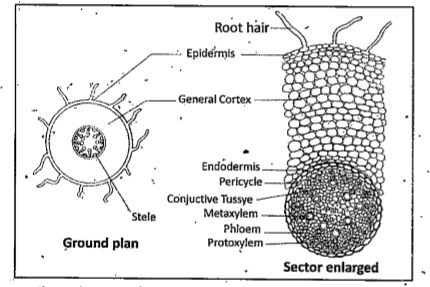Describe the internal structures of a Monocot Root .Solution in Telugu
A . Internal structure of monocot root is differentiated into three zones - epidermis, cortex and stele:
I . Epidermis :
1) The outermost layer is called epidermis. Cells are living, rectangular, thin walled. They are compactly arranged without intercellular spaces.
(2) Cuticle and stomata are absent.
(3) Some cells (trichoblasts) show tubular extensions - root hairs. Epidermis of root having root hairs is called epiblema or piliferous layer or rhizodermis.
(4) Root hairs help in the absorption of capillary water form the soil.. Epidermis gives protection to the inner tissues.
II. Cortex : This is the ground.tissue system extending from epidermis to stele. It is differentiated into three parts.
(A) Exodermis :
(1) It is the outermost layer of the cortex with 2 or 3 rows of cells .Cell walls are thick and suberised.
(2) It acts as a protective layer when epidermis is removed.
(3) It prevents the exit of water from cortex
(B) General cortex :
(1) It is present beneath the exodermis.
(2) It has several layers of loosely arranaged thin walled parenchyma. Intercellular spaces are present.
(3) Cells store food materials.
(4) General cortex helps in the lateral conduction of water from epidermis to. xylem vessels.

(C ) Endodermis :
(1) It is the innermost layer of the cortex.
(2) It is made up of a single layer of barrel shaped cells.
(3) Radial and transverse walls of endodermal cells show thickenings due to the deposition of lignin and suberin. These are called Casparian thickenings.
(4) Endodermal cells present opposite to protoxylem are thin walled without casparian strips. These cells are called passage cells.
(5) Passage cells help in the entry of water and salts from cortex into stele
III. Stele : The central conducting cylinder is called stele. It is very prominent and bigger in size. It shows three parts.
(A) Pericycle:
(1) t is the outermost layer of the stele. It is uniseriate with thin walled parenchymatous cells.
(3) old roots it becomes sclerenchymatous and gives mechanical strength .
(B) Vascular bundles :
(1) Xylem and phloem are arranged alternately on separate radii .So vascular bundles are radial or separate.
(2) Protoxylem is towards pericycle and metaxylem towards centre .So xylem is exarch .
(3) Xylem is polyarch (numerous xylem groups).
(4) Cambium is absent.
(5) Xylem is concerned with conduction of water and salts. Phloem conducts organic solutes.
(6) Parenchyma tissue extending between xylem and phloem strands is called conjunctive tissue. Cells are rarely thick walled. It is helpful in storage of food and provides mechanical strength.
(C ) Medulla or pith - The central part of stele is called medulla or pith. It is conspicuous. It is parenchymatous. It helps in storage of food. In some plants cell walls are lignified providing mechanical strength.
Topper's Solved these Questions
- MODEL PAPER 5BOOK - VGS PUBLICATION-BRILLIANTCHAPTER - MODEL PAPER 5EXERCISE - SECTION - B
8 Videos
- FINAL TOUCH MOST IMPORTANT QUESTIONSBOOK - VGS PUBLICATION-BRILLIANTCHAPTER - FINAL TOUCH MOST IMPORTANT QUESTIONSEXERCISE - UNIT - VIII : ECOLOGY AND ENVIRONMENT ( LONG ANSWER TYPE QUESTIONS)
1 Videos
- MODEL PAPER - 14BOOK - VGS PUBLICATION-BRILLIANTCHAPTER - MODEL PAPER - 14EXERCISE - Section - B
3 Videos
Similar Questions
What are the characteristic features of Euglenoids?
View SolutionDescribe lake as an ecosystem giving examples for the various zones and the biotic components in it.
View SolutionDescribe the structure of cardiac muscle.
View Solutionएकबीजपत्री तने की आन्तरिक संरचना को चित्र की सहायता से समझाइए।
View Solutionएकबीजपत्री जड़ की संरचना का सचित्र वर्णन कीजिए।
View SolutionDescribe the internal structure of a monocot stem.
View SolutionDescribe the vascular bundle of a monocot root.
View SolutionDescribe internal structure of microsporangium
View SolutionDescribe internal structure of dicot root.
OR
Describe internal structure of sunflower root.
View SolutionDescribe internal structure of monocot (Maize) root.
View SolutionDescribe internal structure of monocot stem.
View SolutionDescribe internal structure of Polyarch Root with figure.
View SolutionExplain the primary structure of monocot root.
View SolutionInternal structure OF dicotyledonous root | | Internal structure OF monocotyledonous root
View SolutionDescribe the internal structure of kidney.
View SolutionDescribe the internal structure of a Dicot Root .
View Solution
